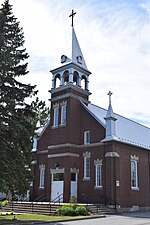Mont-Saint-Hilaire
Cities and towns in QuebecGreater MontrealIncorporated places in La Vallée-du-Richelieu Regional County MunicipalityPages with French IPAPages with non-numeric formatnum arguments ... and 1 more
Use Canadian English from June 2022

Mont-Saint-Hilaire (French pronunciation: [mɔ̃ sɛ̃ nilɛʁ]) is a suburb of Montreal on the South Shore of southeastern Quebec, Canada, on the Richelieu River in the Regional County Municipality of La Vallée-du-Richelieu. The population as of the Canada 2011 Census was 18,200. The city is named after the Mont Saint-Hilaire. A significant deposit of the semi-precious mineral sodalite is located near Mont-Saint-Hilaire.
Excerpt from the Wikipedia article Mont-Saint-Hilaire (License: CC BY-SA 3.0, Authors, Images).Mont-Saint-Hilaire
Rue Saint-Georges,
Geographical coordinates (GPS) Address Nearby Places Show on map
Geographical coordinates (GPS)
| Latitude | Longitude |
|---|---|
| N 45.562222222222 ° | E -73.191666666667 ° |
Address
Rue Saint-Georges
Rue Saint-Georges
J3H 3N8
Quebec, Canada
Open on Google Maps









